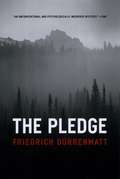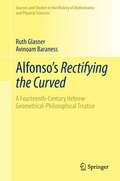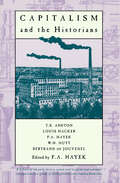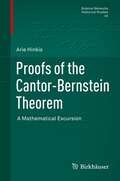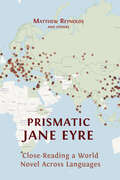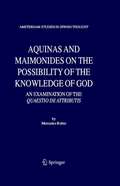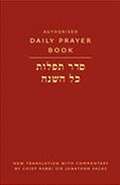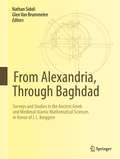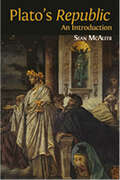- Table View
- List View
Rabbis and Jewish Communities in Renaissance Italy (The Littman Library of Jewish Civilization)
by Robert BonfilFocusing on the figure of the rabbi, this book provides a vivid picture of Italian Jewry during the Renaissance. The author discusses Jewish life of the period (c.1450–1600) in its social, institutional, and cultural aspects, placing them against the backdrop of the wider Catholic environment to give an original interpretation of how Jewish cultural and religious life developed in the Renaissance context. Particular attention is given to changes in the status and functions of the rabbis and to the relations between the rabbinate and the lay leadership. Of special interest is the exploration of the cultural world of the rabbis and the broader issue of intellectual developments at the time. Essentially a translation of Part I of the Hebrew edition, which won wide acclaim for its perspective, Rabbis and Jewish Communities in Renaissance Italy has been carefully adapted for an English-speaking readership. Substantial excerpts from the appendices have been incorporated into the text so that the evidence necessary to support the arguments is easily accessible.
Annunciations: Sacred Music For The Twenty-first Century
by George CorbettAnnunciations comprises three parts. Part I sets out flexible theological and compositional frameworks for a constructive relationship between the sacred and music. Part II presents the reflections of theologians and composers involved in collaborating on new pieces of sacred choral music, alongside the six new scores and links to the recordings. Part III considers the reality of programming and performing sacred works today.
The Pledge
by Friedrich DürrenmattSet in a small town in Switzerland, The Pledge centers around the murder of a young girl and the detective who promises the victim’s mother he will find the perpetrator. After deciding the wrong man has been arrested for the crime, the detective lays a trap for the real killer—with all the patience of a master fisherman. But cruel turns of plot conspire to make him pay dearly for his pledge. Here Friedrich Dürrenmatt conveys his brilliant ear for dialogue and a devastating sense of timing and suspense. Joel Agee’s skilled translation effectively captures the various voices in the original, as well as its chilling conclusion. One of Dürrenmatt’s most diabolically imagined and constructed novels, The Pledge was adapted for the screen in 2000 in a film directed by Sean Penn and starring Jack Nicholson.
Divine Style: Walt Whitman and the King James Bible
by F. W. Dobbs-AllsoppIn exploring the seminal works of Walt Whitman, the great American poet, many commentators have acknowledged the underlying influence of The King James Bible. However, a study has yet to elucidate the precise manner in which the Bible has shaped Whitman’s poetic style. This is the deficit that F. W. Dobbs-Allsopp seeks to address in his new piece of literary scholarship: 'Divine Style: Walt Whitman and the King James Bible'. Dobbs-Allsopp, Professor of Old Testament at Princeton Theological Seminary, explicitly approaches Whitman from the perspective of a biblical scholar. Utilising his wealth of expertise in this field, he constructs a compelling, erudite and methodical argument for the King James Bible’s importance in the evolution of Whitman’s style – from his signature long lines to the prevalence of parallelism and tendency towards parataxis in his works. 'Divine Style' focuses on Whitman’s output in the years preceding the release of his 1855 opus 'Leaves of Grass' through the general period of the book’s first three editions. In this, Dobbs-Allsopp’s exploration of the period is exhaustive – covering not just Leaves of Grass but recently recovered notebooks, newly digitised manuscripts and additions to the corpus, such as the novel 'Life and Adventures of Jack Engle'. This is a work of careful, detailed scholarship, offering an authoritative commentary that will be a valuable resource for students of Whitman, biblical scholars and scholars of literature more generally.
Divine Style: Walt Whitman and the King James Bible
by F. W. Dobbs-AllsoppIn exploring the seminal works of Walt Whitman, the great American poet, many commentators have acknowledged the underlying influence of The King James Bible. However, a study has yet to elucidate the precise manner in which the Bible has shaped Whitman’s poetic style. This is the deficit that F. W. Dobbs-Allsopp seeks to address in his new piece of literary scholarship: 'Divine Style: Walt Whitman and the King James Bible'. Dobbs-Allsopp, Professor of Old Testament at Princeton Theological Seminary, explicitly approaches Whitman from the perspective of a biblical scholar. Utilising his wealth of expertise in this field, he constructs a compelling, erudite and methodical argument for the King James Bible’s importance in the evolution of Whitman’s style – from his signature long lines to the prevalence of parallelism and tendency towards parataxis in his works. 'Divine Style' focuses on Whitman’s output in the years preceding the release of his 1855 opus 'Leaves of Grass' through the general period of the book’s first three editions. In this, Dobbs-Allsopp’s exploration of the period is exhaustive – covering not just Leaves of Grass but recently recovered notebooks, newly digitised manuscripts and additions to the corpus, such as the novel 'Life and Adventures of Jack Engle'. This is a work of careful, detailed scholarship, offering an authoritative commentary that will be a valuable resource for students of Whitman, biblical scholars and scholars of literature more generally.
Alfonso's Rectifying the Curved: A Fourteenth-Century Hebrew Geometrical-Philosophical Treatise (Sources and Studies in the History of Mathematics and Physical Sciences)
by Ruth Glasner Avinoam BaranessThis volume offers a new English translation, introduction, and detailed commentary on Sefer Meyasher 'Aqov, (The Rectifying of the Curved), a 14th-century Hebrew treatise on the foundation of geometry. The book is a mixture of two genres: philosophical discussion and formal, Euclidean-type geometrical writing. A central issue is the use of motion and superposition in geometry, which is analyzed in depth through dialog with earlier Arab mathematicians. The author, Alfonso, was identified by Gita Gluskina (the editor of the 1983 Russian edition) as Alfonso of Valladolid, the converted Jew Abner of Burgos. Alfonso lived in Castile, rather far from the leading cultural centers of his time, but nonetheless at the crossroad of three cultures. He was raised in the Jewish tradition and like many Sephardic Jewish intellectuals was versed in Greek-Arabic philosophy and science. He also had connections with some Christian nobles and towards the end of his life converted to Christianity. Driven by his ambition to solve the problem of the quadrature of the circle, as well as other open geometrical problems, Alfonso acquired surprisingly wide knowledge and became familiar with several episodes in Greek and Arabic geometry that historians usually consider not to have been known in the West in the fourteenth century. Sefer Meyasher 'Aqov reflects his wide and deep erudition in mathematics and philosophy, and provides new evidence on cultural transmission around the Mediterranean.
Rashi (The Littman Library of Jewish Civilization)
by Avraham GrossmanTo this day, the commentaries on the Bible and Talmud written by the eleventh-century scholar known as Rashi remain unsurpassed. His influence on Jewish thinking was, and still is, significant. His commentary on the Pentateuch was the first Hebrew book to be printed, giving rise to hundreds of supercommentaries. Christian scholars, too, have relied heavily on his explanations of biblical texts. In this volume Avraham Grossman presents a masterly survey of the social and cultural background to Rashi’s work and pulls together the strands of information available on his life, his personality, his reputation during his lifetime, and his influence as a teacher. He discusses each of his main commentaries in turn, including such aspects as his sources, his interpretative method, his innovations, and his style and language. Attention is also given to his halakhic monographs, responsa, and liturgical poems. Despite Rashi’s importance as a scholar and the vast literature published about him, two central questions remain essentially unanswered: what was Rashi’s world-view, and was he a conservative or a revolutionary? Professor Grossman considers these points at length, and his in-depth analysis of Rashi’s world-view—particularly his understanding of Jewish uniqueness, Jewish values, and Jewish society—leads to conclusions that are likely to stimulate much debate.
Stories from Quechan Oral Literature
by A. M. Halpern Amy MillerThe Quechan are a Yuman people who have traditionally lived along the lower part of the Colorado River in California and Arizona. They are well known as warriors, artists, and traders, and they also have a rich oral tradition. The stories in this volume were told by tribal elders in the 1970s and early 1980s. The eleven narratives in this volume take place at the beginning of time and introduce the reader to a variety of traditional characters, including the infamous Coyote and also Kwayúu the giant, Old Lady Sanyuuxáv and her twin sons, and the Man Who Bothered Ants. This book makes a long-awaited contribution to the oral literature and mythology of the American Southwest, and its format and organization are of special interest. Narratives are presented in the original language and in the storytellers’ own words. A prosodically-motivated broken-line format captures the rhetorical structure and local organization of the oral delivery and calls attention to stylistic devices such as repetition and syntactic parallelism. Facing-page English translation provides a key to the original Quechan for the benefit of language learners. The stories are organized into "story complexes”, that is, clusters of narratives with overlapping topics, characters, and events, told from diverse perspectives. In presenting not just stories but story complexes, this volume captures the art of storytelling and illuminates the complexity and interconnectedness of an important body of oral literature. Stories from Quechan Oral Literature provides invaluable reading for anyone interested in Native American cultural heritage and oral traditions more generally.
Capitalism and the Historians
by F. A. HayekThe views generally held about the rise of the factory system in Britain derive from highly distorted accounts of the social consequences of that system—so say the distinguished economic historians whose papers make up this book. The authors offer documentary evidence to support their conclusion that under capitalism the workers, despite long hours and other hardships of factory life, were better off financially, had more opportunities, and led a better life than had been the case before the Industrial Revolution.
Capitalism and the Historians
by F. A. HayekThe views generally held about the rise of the factory system in Britain derive from highly distorted accounts of the social consequences of that system—so say the distinguished economic historians whose papers make up this book. The authors offer documentary evidence to support their conclusion that under capitalism the workers, despite long hours and other hardships of factory life, were better off financially, had more opportunities, and led a better life than had been the case before the Industrial Revolution.
Studies in Rabbinic Hebrew
by Shai HeijmansThis volume presents a collection of articles centring on the language of the Mishnah and the Talmud – the most important Jewish texts (after the Bible), which were compiled in Palestine and Babylonia in the latter centuries of Late Antiquity. Despite the fact that Rabbinic Hebrew has been the subject of growing academic interest across the past century, very little scholarship has been written on it in English. Studies in Rabbinic Hebrew addresses this lacuna, with eight lucid but technically rigorous articles written in English by a range of experienced scholars, focusing on various aspects of Rabbinic Hebrew: its phonology, morphology, syntax, pragmatics and lexicon. This volume is essential reading for students and scholars of Rabbinic studies alike, and constitutes the first in a new series, Studies in Semitic Languages and Cultures, in collaboration with the Faculty of Asian and Middle Eastern Studies at the University of Cambridge.
Studies in Rabbinic Hebrew
by Shai HeijmansThis volume presents a collection of articles centring on the language of the Mishnah and the Talmud – the most important Jewish texts (after the Bible), which were compiled in Palestine and Babylonia in the latter centuries of Late Antiquity. Despite the fact that Rabbinic Hebrew has been the subject of growing academic interest across the past century, very little scholarship has been written on it in English. Studies in Rabbinic Hebrew addresses this lacuna, with eight lucid but technically rigorous articles written in English by a range of experienced scholars, focusing on various aspects of Rabbinic Hebrew: its phonology, morphology, syntax, pragmatics and lexicon. This volume is essential reading for students and scholars of Rabbinic studies alike, and constitutes the first in a new series, Studies in Semitic Languages and Cultures, in collaboration with the Faculty of Asian and Middle Eastern Studies at the University of Cambridge.
Proofs of the Cantor-Bernstein Theorem: A Mathematical Excursion (Science Networks. Historical Studies #45)
by Arie HinkisThis book offers an excursion through the developmental area of research mathematics. It presents some 40 papers, published between the 1870s and the 1970s, on proofs of the Cantor-Bernstein theorem and the related Bernstein division theorem. While the emphasis is placed on providing accurate proofs, similar to the originals, the discussion is broadened to include aspects that pertain to the methodology of the development of mathematics and to the philosophy of mathematics. Works of prominent mathematicians and logicians are reviewed, including Cantor, Dedekind, Schröder, Bernstein, Borel, Zermelo, Poincaré, Russell, Peano, the Königs, Hausdorff, Sierpinski, Tarski, Banach, Brouwer and several others mainly of the Polish and the Dutch schools. In its attempt to present a diachronic narrative of one mathematical topic, the book resembles Lakatos’ celebrated book Proofs and Refutations. Indeed, some of the observations made by Lakatos are corroborated herein. The analogy between the two books is clearly anything but superficial, as the present book also offers new theoretical insights into the methodology of the development of mathematics (proof-processing), with implications for the historiography of mathematics.
Meshal Haqadmoni: A Parallel Hebrew-English Text (The Littman Library of Jewish Civilization)
by Raphael LoeweThe wondrous fables of Ibn Sahula in Meshal haqadmoni, presented here in English for the first time, provide a most unusual introduction to the intellectual and social universe of the Sephardi Jewish world of thirteenth-century Spain. Ibn Sahula wrote his fables in rhymed prose, here rendered into English as rhymed couplets. They comprise a series of satirical debates between a cynic and a moralist, put into the mouths of animals; the moralist always triumphs. The debates, which touch on such subjects as time, the soul, the physical sciences and medicine, astronomy, and astrology, amply reflect human foibles, political compromise, and court intrigue. They are suffused throughout with traditional Jewish law and lore, a flavour reinforced by the profusion of biblical quotations reapplied. With parallel Hebrew and English texts, explanatory notes, indication of textual variants, and references for all the biblical and other allusions, this edition has much to offer to scholars in many areas: medieval Hebrew literature, medieval intellectual history, Sephardi studies, and the literature and folklore of Spain. Both the translation and the scholarly annotations reflect Raphael Loewe’s deep understanding of Ibn Sahula’s world, including the interrelationship of Hebrew, Greek, and Arabic speculative thought and the interplay between those languages. Scholars will profit enormously from the textual annotations, and specialist and non-specialist alike will benefit from the masterly introduction. Two full series of illustrations are reproduced alongside the text: the woodcuts from the second edition (Venice, c.1547), and the splendid vignettes in the Rothschild Miscellany, a fifteenth-century Italian mansucript in the Israel Museum.
Diversity and Rabbinization: Jewish Texts and Societies between 400 and 1000 CE
by Daniel Stökl Ben Ezra Gavin McDowell Ron Naiweld, Daniel Stökl Ben Ez NaiweldDiversity and Rabbinization is a welcome contribution to the historical study of Judaism in all its complexity. It presents fresh perspectives on critical questions and allows us to rethink the tension between multiplicity and unity in Judaism during the first millennium CE.
The Hasidic Tale (The Littman Library of Jewish Civilization)
by Gedalyah NigalStory-telling has been an integral part of the hasidic movement from its very beginnings in the eighteenth century to the present day. Stories about the holy hasidic leaders—the tsadikim, or rebbes—and their mystical powers have been a key factor in attracting followers and maintaining their devotion. Such tales were told by the tsadikim and their followers alike. The tsadikim saw them as a way to promote the movement and justify their leadership; their followers saw them as a way to exalt their masters, cleanse them of any shred of imperfection, and defend them from every trace of criticism. No other social or religious movement in the entire course of Jewish history has engaged so intensively in the telling of stories, and nor have stories occupied such a central and important place in any other intellectual movement within Judaism. Originally published in Hebrew and expanded for this English edition by a new introduction, this book is a valuable resource for anyone interested in the history of hasidism or of Hebrew literature and the literary aspects of Jewish popular culture. It acts both as a compendium of stories by theme and as a reference work for the identification of the subject-matter, authors, editors, and editions of books that have been a popular Jewish literary genre since the second half of the eighteenth century. Hasidic tales have been reprinted many times, anthologized, and even quoted by contemporary scholars, without the identity of their authors or editors being known, and without any awareness of their background and origin. In this important work, based on analysis of all the published anthologies as well as tales scattered in a variety of obscure sources, the author traces the sources and development of the different stories. An introductory historical survey is followed by full discussions of the stories themselves, grouped by subject. Among the themes covered are matchmaking and marriages, childbirth and progeny, sickness, death and the world to come, dybbuks and the powers of evil, apostasy, and many more.
Prismatic Jane Eyre: Close-Reading a World Novel Across Languages
by Matthew Reynolds OthersJane Eyre, written by Charlotte Brontë and first published in 1847, has been translated more than five hundred times into over sixty languages. Prismatic Jane Eyre argues that we should see these many re-writings, not as simple replications of the novel, but as a release of its multiple interpretative possibilities: in other words, as a prism. Prismatic Jane Eyre develops the theoretical ramifications of this idea, and reads Brontë’s novel in the light of them: together, the English text and the many translations form one vast entity, a multilingual world-work, spanning many times and places, from Cuba in 1850 to 21st-century China; from Calcutta to Bologna, Argentina to Iran. Co-written by many scholars, Prismatic Jane Eyre traces the receptions of the novel across cultures, showing why, when and where it has been translated (and no less significantly, not translated – as in Swahili), and exploring its global publishing history with digital maps and carousels of cover images. Above all, the co-authors read the translations and the English text closely, and together, showing in detail how the novel’s feminist power, its political complexities and its romantic appeal play out differently in different contexts and in the varied styles and idioms of individual translators. Tracking key words such as ‘passion’ and ‘plain’ across many languages via interactive visualisations and comparative analysis, Prismatic Jane Eyre opens a wholly new perspective on Brontë’s novel, and provides a model for the collaborative close-reading of world literature. Prismatic Jane Eyre is a major intervention in translation and reception studies and world and comparative literature. It will also interest scholars of English literature, and readers of the Brontës.
Prismatic Jane Eyre: Close-Reading a World Novel Across Languages
by Matthew Reynolds OthersJane Eyre, written by Charlotte Brontë and first published in 1847, has been translated more than five hundred times into over sixty languages. Prismatic Jane Eyre argues that we should see these many re-writings, not as simple replications of the novel, but as a release of its multiple interpretative possibilities: in other words, as a prism. Prismatic Jane Eyre develops the theoretical ramifications of this idea, and reads Brontë’s novel in the light of them: together, the English text and the many translations form one vast entity, a multilingual world-work, spanning many times and places, from Cuba in 1850 to 21st-century China; from Calcutta to Bologna, Argentina to Iran. Co-written by many scholars, Prismatic Jane Eyre traces the receptions of the novel across cultures, showing why, when and where it has been translated (and no less significantly, not translated – as in Swahili), and exploring its global publishing history with digital maps and carousels of cover images. Above all, the co-authors read the translations and the English text closely, and together, showing in detail how the novel’s feminist power, its political complexities and its romantic appeal play out differently in different contexts and in the varied styles and idioms of individual translators. Tracking key words such as ‘passion’ and ‘plain’ across many languages via interactive visualisations and comparative analysis, Prismatic Jane Eyre opens a wholly new perspective on Brontë’s novel, and provides a model for the collaborative close-reading of world literature. Prismatic Jane Eyre is a major intervention in translation and reception studies and world and comparative literature. It will also interest scholars of English literature, and readers of the Brontës.
Aquinas and Maimonides on the Possibility of the Knowledge of God: An Examination of The Quaestio de attributis (Amsterdam Studies in Jewish Philosophy #11)
by Mercedes RubioThis in-depth study of Thomas Aquinas’ Quaestio de Attributis binds together the findings of previous research on the unique history of this text by reconstructing the historical circumstances surrounding its composition, shows that the Quaestio contains Aquinas’ final answer to the dispute on the divine attributes, and thoroughly examines his interpretation of Maimonides’ position on the issue of the knowledge of God by analysing this and other texts related to it chronologically and doctrinally.
Hebrew Daily Prayer Book (PDF)
by Jonathan Sacks United Synagogue London England StaffThis is the official prayer book for Orthodox Jews in the UK, with supporting commentary by Chief Rabbi Jonathan Sacks. With both Hebrew and English translations on facing pages, and an attractive and readable layout, this Standard Edition Prayer Book is ideal for synagogue use and individual reading.
From Alexandria, Through Baghdad: Surveys and Studies in the Ancient Greek and Medieval Islamic Mathematical Sciences in Honor of J.L. Berggren
by Nathan Sidoli Glen Van BrummelenThis book honors the career of historian of mathematics J.L. Berggren, his scholarship, and service to the broader community. The first part, of value to scholars, graduate students, and interested readers, is a survey of scholarship in the mathematical sciences in ancient Greece and medieval Islam. It consists of six articles (three by Berggren himself) covering research from the middle of the 20th century to the present. The remainder of the book contains studies by eminent scholars of the ancient and medieval mathematical sciences. They serve both as examples of the breadth of current approaches and topics, and as tributes to Berggren's interests by his friends and colleagues.
Horos: Ancient Boundaries and the Ecology of Stone
by Thea PotterIn Horos, Thea Potter explores the complex relationship between classical philosophy and the ‘horos’, a stone that Athenians erected to mark the boundaries of their marketplace, their gravestones, their roads and their private property.
Horos: Ancient Boundaries and the Ecology of Stone
by Thea PotterIn Horos, Thea Potter explores the complex relationship between classical philosophy and the ‘horos’, a stone that Athenians erected to mark the boundaries of their marketplace, their gravestones, their roads and their private property.

